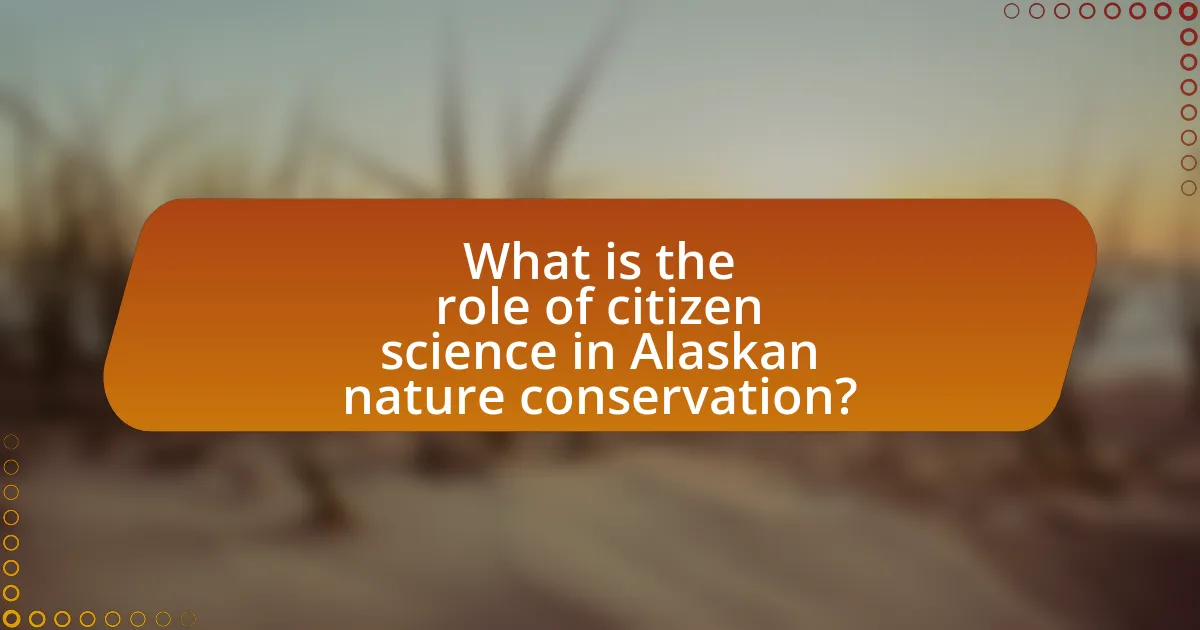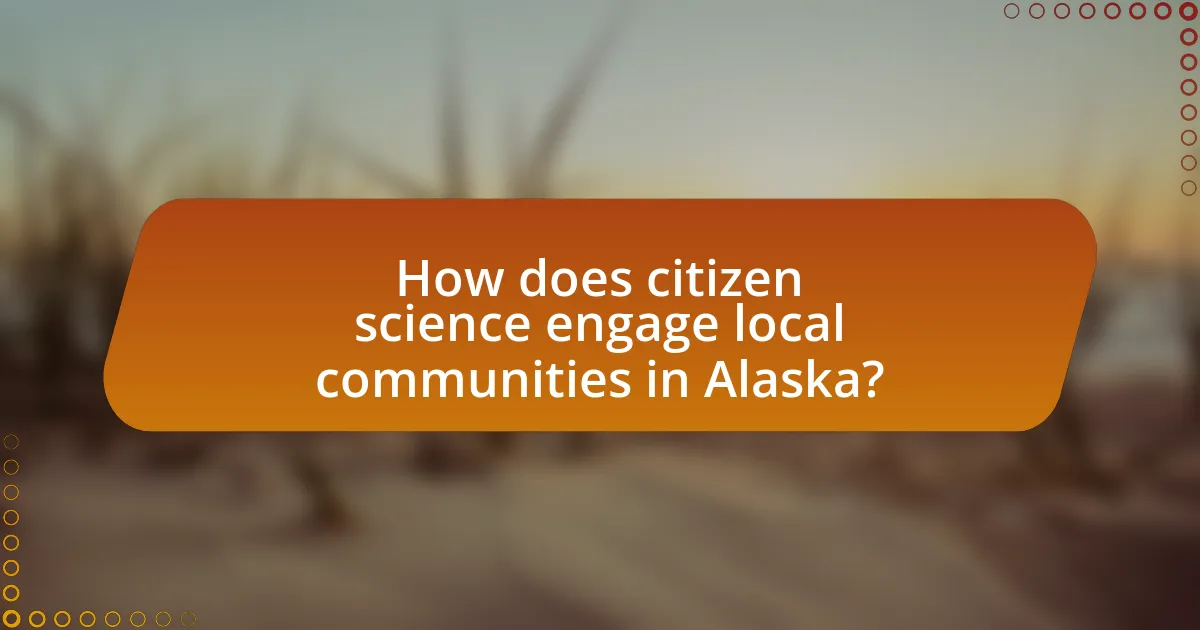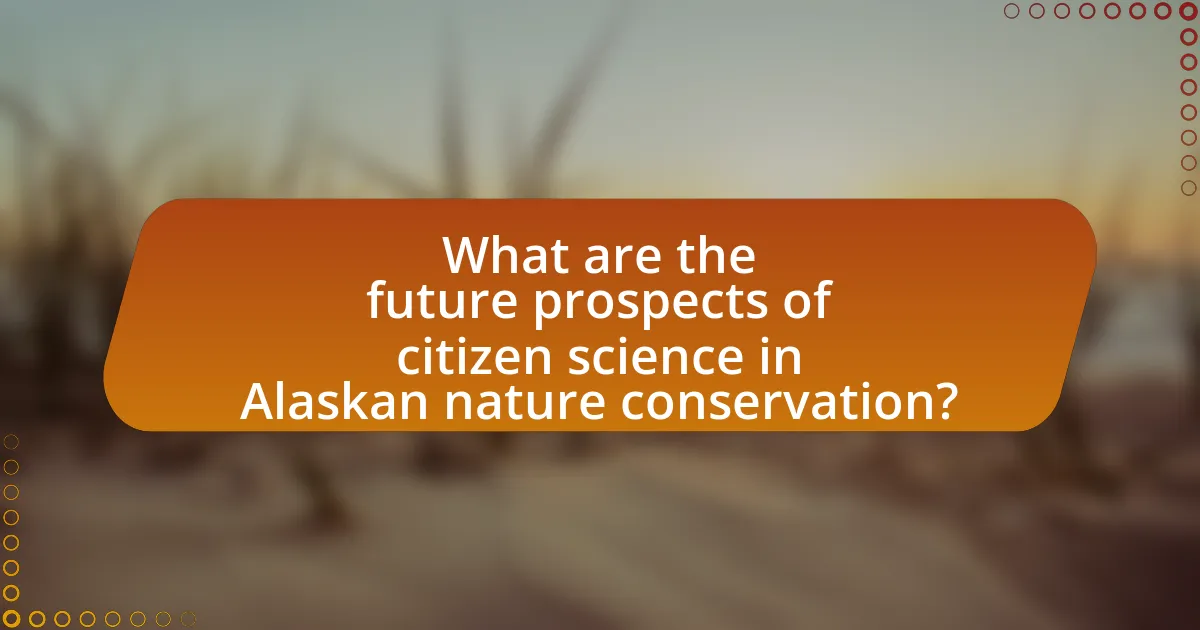Citizen science is a vital component of nature conservation efforts in Alaska, engaging local communities in data collection and monitoring to enhance scientific research on biodiversity, climate change, and ecosystem health. Initiatives such as those by the Alaska Coastal Rainforest Center exemplify how citizen involvement contributes to tracking species populations and habitat conditions, ultimately informing conservation strategies. The article explores the types of data collected by citizen scientists, the challenges they face, and the importance of community engagement in fostering environmental stewardship. Additionally, it discusses the role of technology in facilitating citizen science and the future prospects for these initiatives in supporting Alaskan conservation efforts.

What is the role of citizen science in Alaskan nature conservation?
Citizen science plays a crucial role in Alaskan nature conservation by engaging local communities in data collection and monitoring efforts. This participatory approach enhances scientific research by providing valuable information on biodiversity, climate change impacts, and ecosystem health. For instance, projects like the Alaska Coastal Rainforest Center’s citizen science initiatives have documented species distributions and habitat changes, contributing to more informed conservation strategies. By involving citizens, these efforts not only increase data availability but also foster environmental stewardship and awareness among the public, ultimately supporting the preservation of Alaska’s unique ecosystems.
How does citizen science contribute to environmental monitoring in Alaska?
Citizen science significantly contributes to environmental monitoring in Alaska by engaging local communities in data collection and analysis, which enhances the understanding of ecological changes. For instance, programs like the Alaska Coastal Rainforest Center involve citizens in tracking species populations and habitat conditions, providing valuable data that supports scientific research and conservation efforts. This grassroots involvement not only increases the volume of data collected but also fosters a sense of stewardship among participants, leading to more informed decision-making regarding environmental policies.
What types of data do citizen scientists collect in Alaskan ecosystems?
Citizen scientists in Alaskan ecosystems collect various types of data, including species observations, environmental conditions, and habitat assessments. They document wildlife sightings, such as the presence of specific bird or mammal species, which contributes to biodiversity monitoring. Additionally, they gather data on water quality parameters, such as temperature and pH levels, to assess ecosystem health. Habitat assessments involve recording vegetation types and land use changes, providing insights into ecological dynamics. This data collection supports conservation efforts by informing management strategies and enhancing understanding of ecosystem changes in response to climate variability.
How is this data utilized by conservation organizations?
Conservation organizations utilize data collected through citizen science to inform decision-making, enhance biodiversity monitoring, and guide conservation strategies. This data provides valuable insights into species distribution, population trends, and ecosystem health, which are critical for effective conservation planning. For instance, organizations like the Alaska Department of Fish and Game leverage citizen-reported observations to track wildlife populations and assess habitat conditions, thereby enabling targeted conservation efforts.
Why is citizen science important for biodiversity in Alaska?
Citizen science is important for biodiversity in Alaska because it engages local communities in data collection and monitoring, which enhances scientific research and conservation efforts. In Alaska, where vast and remote areas pose challenges for traditional scientific methods, citizen scientists contribute valuable observations on species distribution, population trends, and environmental changes. For instance, projects like the Alaska Coastal Rainforest Center’s citizen science initiatives have documented shifts in species due to climate change, providing critical data that informs conservation strategies. This collaborative approach not only increases the volume of data available but also fosters public awareness and stewardship of Alaska’s unique ecosystems.
What species are most commonly monitored by citizen scientists?
Citizen scientists most commonly monitor bird species, particularly those that are migratory or have significant ecological roles. For example, the Audubon Society’s Christmas Bird Count engages thousands of volunteers annually to track bird populations across North America, providing critical data on species such as the American Robin and the Bald Eagle. Additionally, citizen scientists often participate in monitoring amphibians, such as frogs and salamanders, due to their sensitivity to environmental changes, which makes them important indicators of ecosystem health. These efforts contribute to large-scale conservation initiatives and enhance our understanding of biodiversity in various ecosystems, including those in Alaska.
How does citizen science help in tracking changes in species populations?
Citizen science aids in tracking changes in species populations by engaging the public in data collection and monitoring efforts. This collaborative approach allows for the gathering of large datasets over wide geographic areas, which would be difficult for scientists to achieve alone. For instance, projects like the Alaska Breeding Bird Survey utilize volunteers to report bird sightings, providing critical data on population trends and distribution changes. Such contributions have been instrumental in identifying shifts in species due to climate change, habitat loss, and other environmental factors, thereby enhancing conservation strategies and informing policy decisions.
What challenges do citizen scientists face in Alaska?
Citizen scientists in Alaska face significant challenges, including harsh environmental conditions, logistical difficulties, and limited access to resources. The extreme weather, such as severe cold and heavy snowfall, can hinder data collection and fieldwork. Additionally, the vast and remote landscapes of Alaska make it challenging for citizen scientists to reach study sites, often requiring extensive travel and planning. Limited funding and resources further complicate their efforts, as many citizen scientists rely on personal finances or small grants to support their projects. These factors collectively impact the effectiveness and sustainability of citizen science initiatives in the region.
How do environmental conditions affect citizen science efforts?
Environmental conditions significantly influence citizen science efforts by affecting participant engagement, data collection accuracy, and the types of projects that can be undertaken. For instance, extreme weather events, such as heavy snowfall or flooding, can limit access to study sites, thereby reducing volunteer participation and hindering data collection. Additionally, varying environmental conditions can impact the behavior of wildlife, which in turn affects the reliability of data gathered by citizen scientists. Research indicates that in Alaska, changing climate patterns have led to shifts in species distribution, making it crucial for citizen science projects to adapt to these changes to ensure relevant and accurate data collection.
What training and resources are needed for effective citizen science?
Effective citizen science requires training in data collection methods, species identification, and project-specific protocols, along with access to resources such as field guides, online training modules, and community workshops. Research indicates that structured training enhances participant engagement and data quality, as seen in programs like the Alaska Coastal Rainforest Center’s citizen science initiatives, which provide comprehensive training and resources tailored to local ecosystems. These elements ensure that citizen scientists can contribute valuable data for conservation efforts in Alaska.

How does citizen science engage local communities in Alaska?
Citizen science engages local communities in Alaska by involving residents in data collection and environmental monitoring, fostering a sense of ownership and stewardship over local natural resources. Programs such as the Alaska Coastal Rainforest Center’s citizen science initiatives enable community members to participate in research projects that track changes in biodiversity and climate, directly linking their observations to scientific outcomes. This engagement not only enhances scientific understanding but also empowers local populations by providing them with valuable skills and knowledge about their environment, thereby strengthening community ties and promoting conservation efforts.
What are the benefits of community involvement in conservation efforts?
Community involvement in conservation efforts enhances ecological outcomes and fosters sustainable practices. Engaging local populations leads to increased awareness and education about environmental issues, which can result in more effective conservation strategies. For instance, studies have shown that communities actively participating in conservation initiatives often report higher levels of biodiversity and improved ecosystem health. Additionally, local involvement can lead to better resource management, as community members possess valuable traditional knowledge and a vested interest in the preservation of their environment. This collaborative approach not only strengthens conservation efforts but also builds community resilience and social cohesion, ultimately benefiting both the environment and the people who depend on it.
How does citizen science foster a sense of stewardship among Alaskans?
Citizen science fosters a sense of stewardship among Alaskans by actively engaging them in environmental monitoring and conservation efforts. Through participation in projects like the Alaska Coastal Rainforest Center’s citizen science initiatives, residents contribute valuable data on local ecosystems, which enhances their understanding of environmental issues. This involvement not only empowers Alaskans to take ownership of their natural surroundings but also cultivates a community-oriented mindset focused on preserving biodiversity and promoting sustainable practices. Studies have shown that when individuals participate in data collection and analysis, they develop a deeper emotional connection to their environment, leading to increased advocacy for conservation efforts.
What role do local knowledge and traditions play in citizen science projects?
Local knowledge and traditions are crucial in citizen science projects as they enhance data collection and interpretation, particularly in unique ecosystems like Alaska. Indigenous communities possess extensive understanding of local flora, fauna, and environmental changes, which can significantly inform scientific research. For instance, studies have shown that local observations can lead to more accurate assessments of biodiversity and ecosystem health, as evidenced by the collaboration between scientists and Alaska Native communities in monitoring climate change impacts on wildlife. This integration of traditional ecological knowledge with scientific methods not only enriches the research but also fosters community engagement and stewardship in conservation efforts.
How can citizen science initiatives be improved to enhance community participation?
Citizen science initiatives can be improved to enhance community participation by increasing accessibility and providing targeted training for participants. Research indicates that when citizen science projects are designed with user-friendly platforms and clear instructions, participation rates rise significantly. For example, a study published in the journal “Citizen Science: Theory and Practice” found that projects that offered workshops and hands-on training saw a 40% increase in volunteer engagement. Additionally, fostering local partnerships with schools and community organizations can create a sense of ownership and relevance, further driving participation.
What strategies can be employed to increase awareness and involvement?
To increase awareness and involvement in citizen science for Alaskan nature conservation, targeted community engagement strategies should be employed. These strategies include organizing local workshops and informational sessions that educate residents about the benefits and impact of citizen science, thereby fostering a sense of ownership and responsibility towards local ecosystems. Additionally, leveraging social media campaigns can effectively reach a broader audience, sharing success stories and ongoing projects to inspire participation. Research indicates that community-based initiatives, such as collaborative projects with schools and local organizations, enhance public interest and involvement, as evidenced by the success of programs like the Alaska Coastal Rainforest Center, which actively engages citizens in data collection and conservation efforts.
How can technology be leveraged to facilitate citizen science in remote areas?
Technology can be leveraged to facilitate citizen science in remote areas by utilizing mobile applications, satellite imagery, and data collection tools that enable local communities to participate in scientific research. For instance, mobile apps allow users to record observations of wildlife and environmental changes, which can be uploaded in real-time to centralized databases. Satellite imagery provides researchers with up-to-date information on land use and ecological changes, enhancing the data collected by citizen scientists. Additionally, tools like GPS devices and drones can assist in mapping and monitoring remote ecosystems, making it easier for citizens to contribute valuable data. These technological advancements have been shown to increase participation rates and improve data quality in citizen science projects, as evidenced by studies such as “The Role of Technology in Citizen Science” published in the journal Citizen Science: Theory and Practice, which highlights successful case studies in remote regions.

What are the future prospects of citizen science in Alaskan nature conservation?
The future prospects of citizen science in Alaskan nature conservation are promising, as it enhances data collection and public engagement in environmental monitoring. Citizen science initiatives, such as the Alaska Coastal Rainforest Center’s community-based projects, have demonstrated that local involvement can lead to more comprehensive ecological data and increased awareness of conservation issues. Furthermore, the integration of technology, such as mobile apps for reporting wildlife sightings, is expected to expand participation and improve data accuracy. Studies indicate that citizen-contributed data can complement traditional scientific research, making it a valuable resource for conservation efforts in Alaska.
How is technology shaping the future of citizen science in Alaska?
Technology is significantly shaping the future of citizen science in Alaska by enhancing data collection, analysis, and community engagement. Mobile applications and online platforms enable Alaskan citizens to easily report observations, such as wildlife sightings and environmental changes, contributing to large datasets that researchers can analyze. For instance, the use of the iNaturalist app allows users to document biodiversity, which aids in tracking species distribution and health. Additionally, remote sensing technologies, including drones and satellite imagery, provide critical data on habitat changes and climate impacts, facilitating more informed conservation efforts. These technological advancements not only streamline the research process but also empower local communities to actively participate in scientific endeavors, fostering a collaborative approach to nature conservation in Alaska.
What emerging tools and platforms are being used for data collection?
Emerging tools and platforms for data collection in citizen science include mobile applications, remote sensing technologies, and online data repositories. Mobile applications like iNaturalist and eBird enable users to record and share observations of wildlife, contributing to large datasets that researchers can analyze. Remote sensing technologies, such as drones and satellite imagery, provide high-resolution data for monitoring environmental changes and wildlife habitats. Online data repositories, including platforms like Zooniverse, facilitate collaboration among citizen scientists and researchers, allowing for the aggregation and analysis of diverse data sources. These tools enhance the capacity for data collection in nature conservation efforts, particularly in regions like Alaska, where traditional data collection methods may be challenging.
How can social media enhance citizen engagement in conservation efforts?
Social media can enhance citizen engagement in conservation efforts by providing platforms for information sharing, community building, and mobilization of resources. These platforms allow organizations and individuals to disseminate real-time updates about conservation initiatives, share success stories, and raise awareness about environmental issues. For instance, campaigns like #TrashTag have successfully mobilized thousands of volunteers to clean up litter in various locations, demonstrating the power of social media in organizing collective action. Additionally, studies show that social media can increase public participation in conservation activities by up to 50%, as it fosters a sense of community and shared responsibility among users.
What best practices can be adopted for successful citizen science projects?
Successful citizen science projects can be achieved by implementing clear communication, structured training, and effective data management. Clear communication ensures that participants understand project goals and their roles, which enhances engagement and data quality. Structured training equips volunteers with the necessary skills and knowledge, leading to more accurate data collection. Effective data management involves establishing protocols for data entry, storage, and sharing, which maintains data integrity and accessibility. Research indicates that projects with these best practices, such as the Alaska Coastal Rainforest Center’s citizen science initiatives, have seen increased volunteer retention and improved scientific outcomes.
How can partnerships between scientists and citizens be strengthened?
Partnerships between scientists and citizens can be strengthened by fostering collaborative research initiatives that actively involve citizens in data collection and analysis. Engaging citizens in projects, such as monitoring wildlife populations or tracking environmental changes, enhances community investment in scientific outcomes. For instance, programs like the Alaska Coastal Rainforest Center’s citizen science projects have successfully integrated local knowledge and participation, leading to more comprehensive data and increased public awareness of conservation issues. This collaborative approach not only enriches scientific research but also empowers citizens, creating a shared responsibility for environmental stewardship.
What are the key factors for sustaining citizen science initiatives in Alaska?
Key factors for sustaining citizen science initiatives in Alaska include community engagement, funding stability, and effective data management. Community engagement fosters local participation and ownership, which is crucial for long-term commitment; for instance, initiatives that involve local residents in research and conservation efforts tend to see higher retention rates. Funding stability ensures that projects can continue over time, as many citizen science initiatives rely on grants and donations, which can fluctuate. Effective data management is essential for maintaining the quality and usability of the data collected, as demonstrated by successful projects that implement robust data-sharing platforms and training for volunteers. These factors collectively contribute to the resilience and impact of citizen science in Alaska’s unique environmental context.


